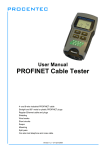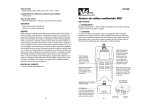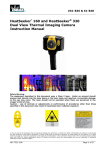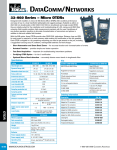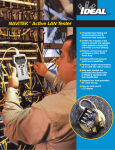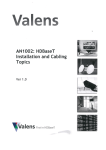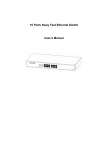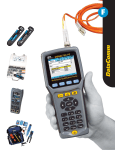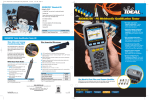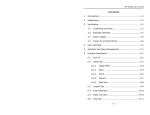Download VDV Instructions - Clark Wire & Cable
Transcript
#33-856 VDV MultiMedia Cable Tester OPERATING INSTRUCTIONS WARNING! Do not attach to AC power. The VDV MultiMedia Cable Tester may be damaged and cause a safety hazard for the user. CAUTION! Improperly crimped, damaged or un-crimped plugs can damage the jacks on the VDV MultiMedia Cable Tester. Inspect plugs for proper termination and crimping before inserting into the tester. Contacts should always be recessed into the plastic grooves of the plug. Do not use 6-position (phone) plugs with the 8-position (data) jack. VOICE (Telephone) Press to power on and begin testing. Uses 3-pair USOC standard and 6-position RJ jack. DATA (Data Network) Press to power on and begin testing. Uses T568A/B standard and 8-position RJ jack. COAX TEST TERMINATOR REMOTE UNIT Squeeze remote at finger grip openings in main unit to remove. Use same connector on remote as on main unit. VIDEO (Video/Security) Press to power on and begin testing. Tests for shorts and opens. Use with test terminator stored in back of RJ remote at bottom of tester. TONE (Tone Generator) Press a cable test button for the connector being used followed by the TONE button. Displays pins being driven in terms of that connector. REMOTE UNIT (Front view) VOICE DATA Features: • Tests voice (6-wire), data (8-wire) and video (coax) cabling systems • Large seven-segment LCD with icons for clear results • Cable test results displayed in wire map format • Tests for shorts, opens, miswires, reversals and split pairs • Displays PASS icon for correctly wired T568A/B, both one-to-one and uplink (cross-over) cables • Displays PASS icon for correctly wired 6-pin telephone cables both straight-through and reversed • Tone generator mode for use with tone tracers • Auto-off in any mode and low power consumption for long battery life • Modular Plug Remote and Video Test Terminator store in the bottom end of the case The VDV MultiMedia Cable Tester is designed to test all common low voltage cabling systems found in today’s automated homes; voice, data or video networks. The VDV MultiMedia Cable Tester has a large, bright LCD display and four momentary buttons used to directly access each function. The remote attaches to the main unit for storage and patch cable testing. The VDV MultiMedia Cable Tester is turned on by pressing any one of the four momentary function buttons and begins testing in the mode for the button pressed Telephone (VOICE), Data Network (DATA), Video/Security (VIDEO), or Tone Generator (TONE). The corresponding connectors at the top end of the tester are labeled the same as their mode switches. An LCD icon for the currently selected mode will be on or flashing on the screen. To turn the VDV MultiMedia Cable Tester off when in one of the cable test modes, press the button for a different cable test mode, but not the TONE button. Pressing the TONE button will start the tone generator in the Tel Tone, the Video Tone or Data Tone mode, depending on the current cable test mode. The tone mode will be discussed in detail later on in this section. Upon completion of a voice or data cable test, the wire map display, ID and any faults are displayed. The top line of numbers on the display represents the connector pins on the main unit. The second line of pin numbers represents the connector pin numbers of the remote, normally being the same as the top line for a one-to-one wired cable. If there is a miswire, the pin numbers on the second line will indicate the pin numbers detected and the “Fail” icon will be on. The icon and the pins involved in the error will flash. If no connection was detected for some of the pins, the first and second line of pin numbers will be blank in those pin locations. If a short is detected, the second line will have a ‘-’ in those positions along with the “Short” icon being on. If a split pair is detected, those pin positions on the first and second line will be flashing the pin numbers detected from the remote and the “Split” icon will be flashing. If there are multiple errors to display, there will be a combination of the above error displays. The ID icon will have a number directly to the right of it, indicating the remote ID number detected from the remote. A new test is in progress whenever the “Voice” or “Data” icons are on. In the video mode, the “Open”, “Short” or “Pass” icon will be on to indicate the results of a test. If the cable passes, the “ID” icon will be on as well as a remote ID number, on the bottom line of the display. The “Video” icon turns on when a test is in progress. 2 As mentioned above, the tone generator operates in Voice, Data and Video modes. The different modes are provided so that the pins or pairs being driven with a tone signal are displayed in terms of one of the three connectors. The specific mode is selected by pressing one of the cable test buttons (VOICE, VIDEO or DATA) followed by the TONE button. If the VDV MultiMedia Cable Tester was off when the TONE button is pressed, the last cable test mode used will be selected. The tone generator saves the driven pins for each mode independently. For example, selecting a different pin to drive in network mode will not change the driven pin in video mode. Pressing any cable test mode button will turn off the VDV MultiMedia Cable Tester when in tone mode. 1. VOICE Cable Test Mode – The VDV MultiMedia Cable Tester assumes the 6-position jack on the main unit and the remote will be used for connecting the tester to the cable run to be tested. This mode uses the 3-pair USOC standard to define the pairs. Connector pins 1-6, 2-5 and 3-4 are the pairs defined by this standard. The tester will display the “Pass” icon when all 6 pins are correctly wired in a one-to-one order. If all 6 pins are correctly wired in the reverse order, the “Pass” icon along with a flashing “Rev” icon will be displayed. Standard telephone cables used between a phone set and a wall jack are usually reverse-pinned. 2. DATA Cable Test Mode – The VDV MultiMedia Cable Tester assumes the 8-position jack on the main unit and the remote will be used for connecting the tester to the cable run to be tested. The TIA/EIA568A/B standard is used to define the pairs. Connector pins 1-2, 3-6, 4-5 and 7-8 are the pairs defined by this standard. The A and B standards are the same except for color-coding and are indistinguishable from each other by electrical testing. The tester will display the “Pass” icon when all 8 pins are correctly wired in a one-to-one order. If all 8 pins are correctly wired with the 1-2 and 3-6 pairs crossed, the “Pass” icon will be displayed along with a flashing “Uplink” icon. Uplink cables are also known as crossover or T568A to T568B cables and are commonly used to connect two computers or two hub/switches directly together. For shielded data cable, the remote ID will flash alternately with “S” to indicate presence of shielding. 3. VIDEO COAX Cable Test Mode – The VDV MultiMedia Cable Tester can test for open, shorts and ID. 4. TONE – The tone mode generates audio tones for use with tone tracers on all pairs, a selected pair or a selected pin. The signal generated on a pair has the signal on one pin and the complement of the signal on the other pin of the pair, yielding a nominal 10 volts peak-to-peak across the pair. The pin number of the pin or the letters “P” (for pin) and “S”(for shield) being driven with tone and the currently selected tone pattern are displayed on the screen along with the “Tone” icon and the icon for the connector assumed to be used. Once in the tone generator mode, the TONE button steps to the next connector pin(s) drive option for presses of less than 2 seconds. When the TONE button is pressed and held down for longer than 2 seconds, the tone pattern options are stepped through in turn until the button is released. The tone pattern options are Hi, Lo, HiLo1 and HiLo2. The HiLo options are dual or warble tones of differing pattern duration. Pressing any button other than TONE turns off the VDV MultiMedia Cable Tester. The tone will turn off automatically after about 2.4 hours. 3 Volts! – The VDV MultiMedia Cable Tester monitors for voltage being present on the jacks during each test cycle. If voltage is found, the “Volts!” icon is displayed and testing stops until the voltage is removed. INSTRUCTIONS Instructions for Use VDV MultiMedia Cable Tester powers off automatically 9 minutes after the last button press in cable testing modes and after 2.4 hours in tone mode. Be sure to install a battery if using for the first time, see battery installation section. CABLE TESTING To Test Voice/Data Patch Cable (see caution about cables with bad plugs above) 1. Plug one end of patch cable into main unit. 2. Plug other end of cable into remote unit. 3. Press VOICE or DATA as appropriate for the jack the patch cable is connected to. The VDV MultiMedia Cable Tester will turn on and begin a testing. If tester was already on, press VOICE or DATA to initiate a new test. Results are invalid if a cable is attached during a test in progress. 4. To turn VDV MultiMedia Cable Tester off, press VIDEO button. To Test Video/Security Coax Cable 1. Attach one end of coax cable to be tested to F-connector on main unit. 2. Remove remote unit from main unit by squeezing the remote lightly between the thumb and forefinger through the openings provided in the main unit and pull out of storage pocket. Remove video remote from storage pocket on backside of remote and attach to the other end of the cable to be tested. 3. Press the VIDEO button to turn on the unit and begin testing. The results are updated about once a second. 4. To turn VDV MultiMedia Cable Tester off, press VOICE or DATA buttons. To Place Tone on a Cable 1. Connect cable to be traced to a main unit jack. For best signal, do not connect a remote to the other end. Due to the shielding effect of twisted pairs, the strongest signal is obtained by having one wire of a pair carry tone. Selecting a single pin instead of a pair will do this. For video coax cable, the Tone is best applied to the shield and the shield cannot be grounded. 4 2. Turn on VDV MultiMedia Cable Tester by pressing the button associated with the connector to be used followed by pressing the TONE button. Short presses of the TONE button will select a different pin. Holding down the TONE button for more than 2 seconds will select a different tone pattern. 3. To turn VDV MultiMedia Cable Tester off, press any button except TONE. The tone will turn off automatically after about 2.4 hours. INTERPRETING CABLE TEST RESULTS The Pass icon will be on if the cable has all pins properly connected per T568A/B for network cables or per 3-pair USOC for telephone cables. The Fail, Short, Open or Split icon will be on if there is a wiring error. The wire map will display the end-to-end connections measured whenever possible. The Pass icon will also be on with a flashing Uplink icon if a network cable has the 1-2 and the 3-6 pairs transposed to indicate a properly wired uplink (crossover) cable. In Voice mode, the Rev icon will flash if all connected pins are in reverse order and the Pass icon will also be on if all 6 connections are present. Telephone modular plug cables used between the wall jack and a phone set are usually reverse pinned. Definition of Errors – The three classes of faults discussed below are in order of severity. The severity has to do with the ability of a more severe error to mask less severe errors. For example, if there is a short in the cable, miswires and split pairs may not be detected for the pairs involved in the short fault. Short – The pair has a low resistance connection from one wire of the pair to the other wire of the pair or to any other wire in the cable or the shield. A short is indicated by the Short icon being on and flashing -’s in the appropriate pin positions on the second line for the pin numbers involved in the shorts plus a flashing S icon if the shield is shorted to a pin. Miswire – A wire or both wires of a pair are not connected to the correct pins at the other end of the cable. The wire map shows the pin numbers line 1 (main) line 2 (remote). A reverse pair is a special case of a miswire in which the pair is wired to the correct pair of pins or to another designated pair of pins, but the two leads are reversed. The VDV MultiMedia Cable Tester is able to test for split pair errors as long as the wiring errors are in pairs. The Fail icon and the pin numbers, which are miswired, will be flashing. Split Pair – A split pair is an error in the twisting of the wires together within the cable. The cables generally are made up of eight wires twisted together in 4 pairs. These 4 pairs are designated as pairs by the wiring standards and are intended to carry a signal and its return. 1 & 2, 3 & 6, 4 & 5 and 7& 8 are the pairs designated by T568A/B for a RJ45 jack or plug. A cable can be wired with correct continuity but not with correct pairing. This most often happens when the cable is terminated consistently at both ends, but in the wrong order. A dynamic or AC test is required to detect this type of error. If the only error is a split pair error, the cable has correct continuity. If cross talk is not a concern, as in flat satin cable, the cable is good if the only error is the split pair error. The Split icon and the pin numbers on the first and second line of the wire map with split pairs flash when there is a split pair error. 5 VDV MultiMedia Cable Tester has the ability to turn off the split pair error testing. Pressing the button for the current cable test mode for more than 2 seconds turns off the split pair testing. The “Split” icon and the word “OFF” appears on the screen momentarily to indicate this. The split pair testing will resume the next time the tester is turned on, or may be toggled back on by another 2 second press of the current test mode button. BATTERY REPLACEMENT When the battery low icon is on, the battery should be replaced as soon as practical. The cable testing results will become unreliable when the battery reaches about 4.5 volts. To replace battery: 1. Remove the screw from the battery door on the back of the unit with a #1 Phillips-head screwdriver. 2. Pull battery out of cavity and remove battery snap. 3. Connect a new Alkaline 9 volt battery to battery snaps. Place battery back into body with battery snaps placed toward front end of compartment. 4. Replace battery door and screw being careful to not over tighten the screw. SPECIFICATIONS Physical Dimensions Size: 13.2 × 7.3 × 4.1 cm (5.2 × 2.9 × 1.6 inches) Weight: 242 grams (8.5 oz.) with battery and remote Environmental Operating temperature: 0 to 50 °C (32 to 122 °F) Storage temperature: -10 to 60 °C (14 to 140 °F) Humidity: 10% to 90%, non-condensing 6 Battery Life (9V Alkaline battery, typical) times are for the full capacity of the battery used continuously in one of the following modes: Standby: 2.5 years Cable Testing: 150 hours Tone Generator: 250 hours Cable Types Data network cable, CAT6, CAT-5E, CAT-5, CAT-4, CAT-3 and Coax Minimum cable length for testing of split pairs 1 meter (3 feet) Video Coax cable 100 ohms maximum DC resistance, center conductor plus shield ACCESSORIES Satin RJ11 patchcord Satin RJ45 patchcord WARRANTY IDEAL guarantees to the end-user purchaser that its products will be free of all defects in material and/or workmanship. This warranty extends for a period of 12 months for the test instrument and 3 months for the cables from the date of manufacture or proof-of-purchase. The obligations of IDEAL under this warranty is limited to the repair or replacement (at our option) during the warranty period, of any part that proves to be defective in material or workmanship under normal use, installation and service, provided the product is returned to IDEAL freight prepaid. A copy of the purchase receipt must accompany products returned to us. In the absence of such a receipt, the warranty period will cease 12 months from the date of manufacture. This warranty does not extend to products that have been subjected to neglect, accidental or improper use, or to units which have been altered, repaired, or inspected by other than IDEAL authorized personnel. In no event will IDEAL be liable for any incidental or consequential damages. The VDV MultiMedia Cable Tester is designed and manufactured to provide trouble-free service. However, if for some reason your tester should require repair, please follow these instructions. SHIPPING 1. Before returning any product to IDEAL, you must first request a Return Goods Authorization Number by contacting our Customer Services Dept. at 800-435-0705. No shipments will be accepted without this number, which must be clearly marked on the shipping label. 2. Ship the equipment with a copy of the sales receipt, if available. 3. Attach a description of the operational problem. 4. Include a contact name, phone number, and e-mail address if possible. 5. Pack securely to prevent damage during shipping. 6. Ship prepaid to: IDEAL INDUSTRIES, INC.; Becker Place; Sycamore, IL 60178 PRODUCT REGISTRATION Please visit www.idealindustries.com IDEAL INDUSTRIES, INC. Sycamore, IL 60178, U.S.A. 800-435-0705 Customer Assistance www.idealindustries.com ND 4715-1










